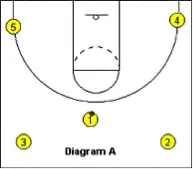Four Corners is a basketball play made famous by legendary University of North Carolina coach, Dean Smith. Essentially, four players stand in the corners of the offensive half-court while the fifth dribbles the ball in the middle (see: Diagram A below). The basketball is passed between the point guard in the middle and the four players making up the corners. This “pre-shot clock” strategy— called the Four Corners— is meant to stall a game by denying the defense a chance to regain possession, and ultimately guarantee a lay-up for the point guard.
Likewise, how can fundraisers guarantee a win in a capital campaign? The answer will make Dean Smith proud: rely on the “Four Corners of a Campaign”: case, leadership, prospects, and plan.

Point Guard (1): You
As the Development Director or Campaign Director, you have the ball and are tasked with managing the capital campaign. It is your job to direct the case for support, volunteer leaders, potential prospects, and overall campaign plan. You oversee all movement from these corners and are constantly analyzing the landscape, or the “basketball court,” to determine where to act next.
Corner (2): Case
After your case elements have been determined, start building the arguments surrounding why this campaign is needed and how you intend to achieve its goal. A strong case for support will always clearly highlight the necessity, not just the desire, to further the mission and work of an organization. The “ball” should be passed back to the case throughout the entire campaign. Once finalized, always revert to the case for support, reminding your organization and donors why these dollars are needed and what you anticipate being the impact.
Corner (3): Leadership
The point guard relies on and guides the leadership in any campaign effort. For true success, the volunteers need to be engaged, regularly updated, and tasked with next steps. Leadership is critical when developing the case and creating and implementing the campaign plan. Campaign leaders and volunteers will also be the main source of interaction and activity with prospects/donors. Passing the ball to campaign leadership, and ensuring they pass the ball to another corner, is critical in campaign movement and will ensure progress.
Corner (4): Prospects
It goes without saying— prospects/donors are the bread and butter of securing dollars. As a prospect moves through the different stages of Moves Management, the point guard/campaign director must always align eyesight with what can be the next Four Corners move. While researching new prospects, or working with long-time donors, always be thinking how the case (Corner) relates to a prospect or could interest them. Perhaps a campaign leader (Corner) has connections with a certain prospect? Or perhaps they could create a unique opportunity or event for a prospect? While working with prospects (Corners), it is imperative to collaborate quickly and often with the other players on the court.
Corner (5): Plan
The campaign plan and individual division plans are the first things written for a campaign. This is the lifeblood of any project. Every action that happens with the other corners must be checked with the plan to ensure all activity is aligned and driven with the campaign purpose. No matter the stage of the campaign, always revert to the plans for guidance.
The goal of the Four Corners is to always keep the ball moving across the corners and, when executed properly, guarantee the point guard a lay-up. As complex campaigns take off and begin to maneuver through the strategic offense and defense of fundraising, it is important to continue moving your actions between the case for support, the campaign leadership, the prospects, and the campaign and division plans.
And best of all, there is no shot-clock!
More Insights
CCS Philanthropy Pulse
Uncover the latest fundraising trends in the 2025 CCS Philanthropy Pulse report! Packed with data-rich insights from 600+ nonprofit organizations across diverse nonprofit sectors, this free report will help you plan for success in 2025.
Making the Case for Endowment at Your Independent School
The COVID-19 pandemic and the fluctuating economy in the years since revealed how critical endowments are for the growth and sustainability of independent schools. Learn how to make the case for an endowment at your school with our concrete tactics.